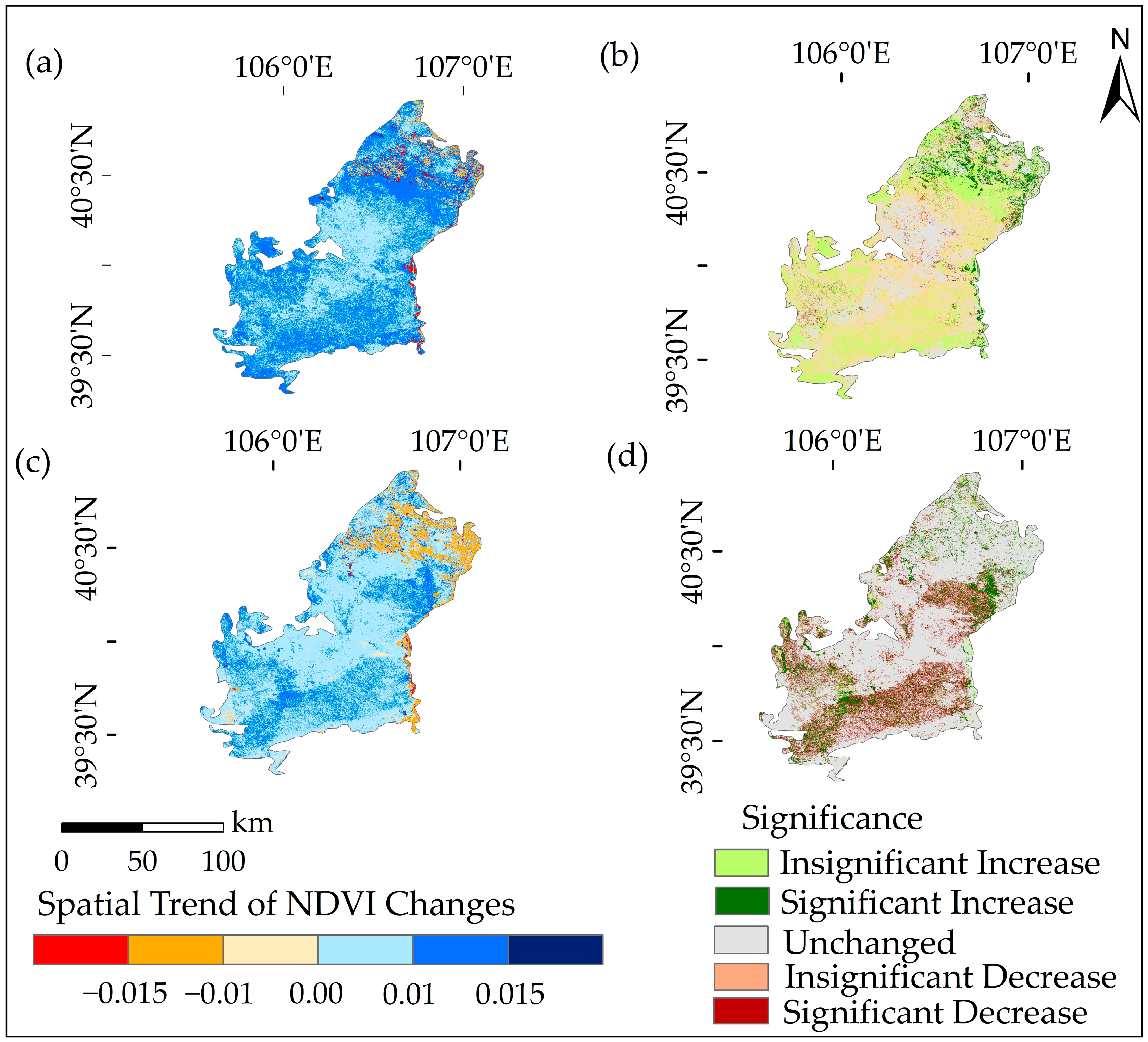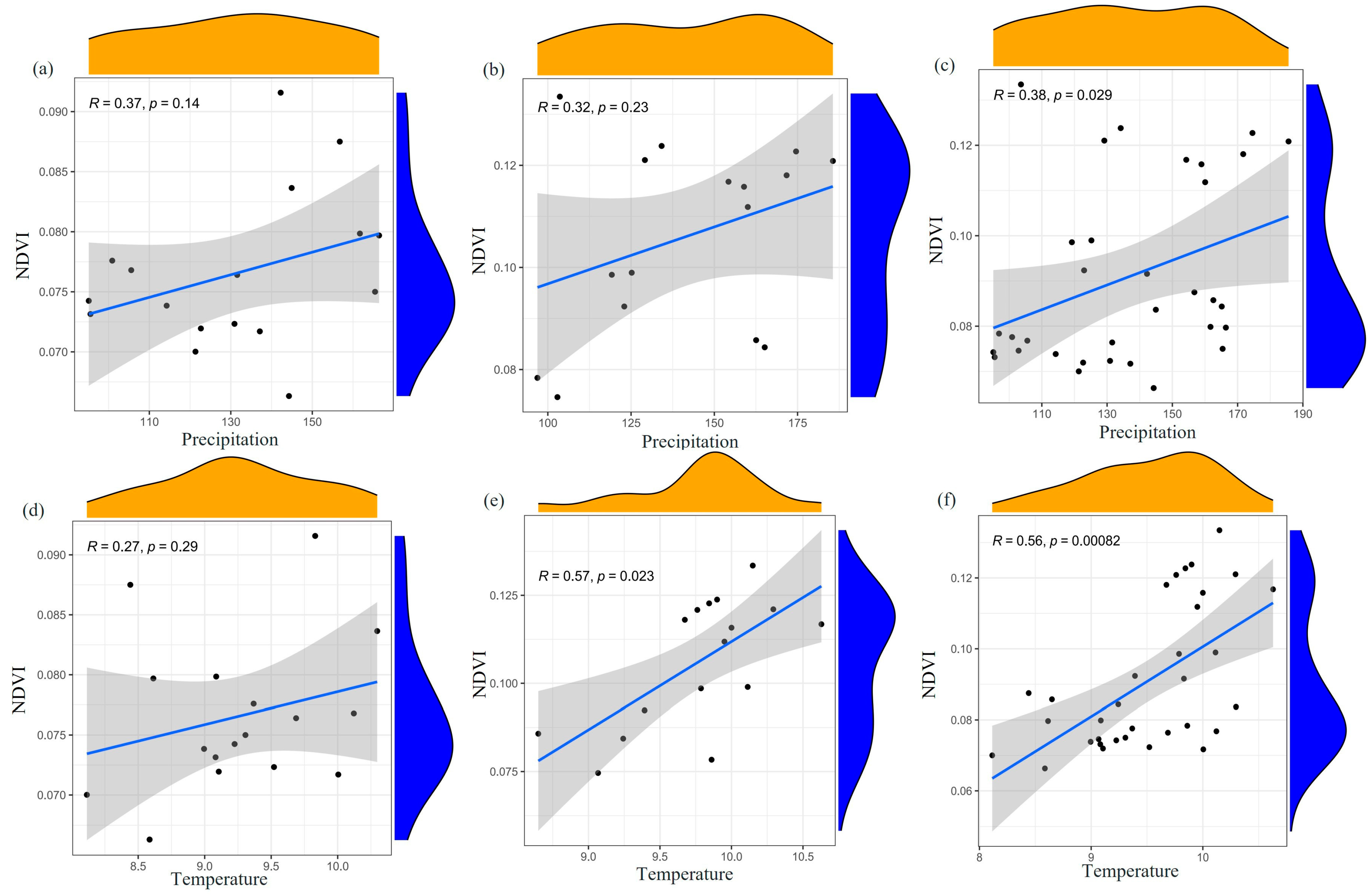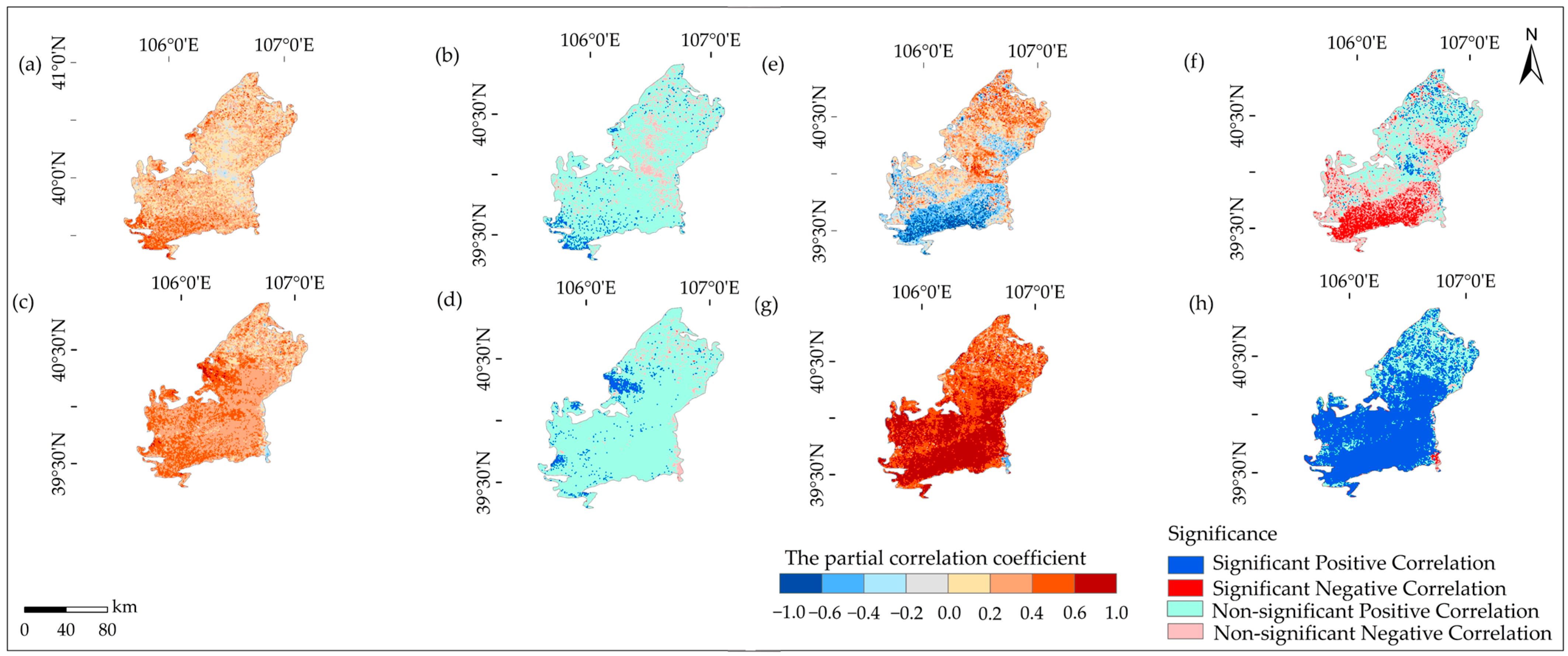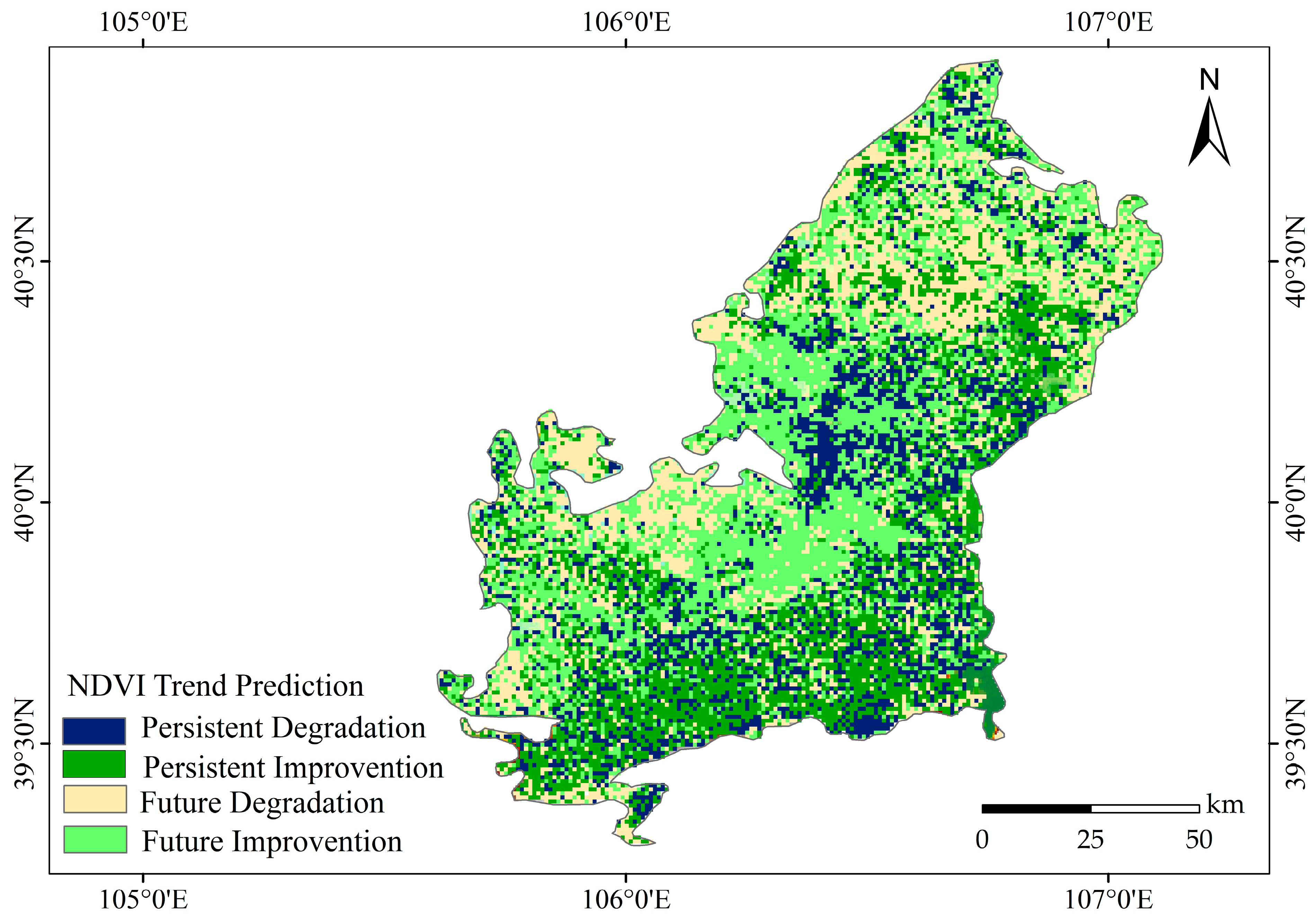Study of Changes in the Ulan Buh Desert under the Dual Impacts of Desert Farmland Development and Climate Change
Abstract
:1. Introduction
2. Results
2.1. Temporal and Spatial Variations in NDVI
2.1.1. Interannual Variation Characteristics
2.1.2. Spatial Variation Characteristics
2.2. Influence of Climate Factors on NDVI
2.2.1. Interannual Variations in Climate Factors

2.2.2. Relationship between Climate Factors and NDVI
2.3. Future Trend of Vegetation
2.4. Future Trend of Vegetation
3. Materials and Methods
3.1. Study Area
3.2. Datasets and Pre-Processing
3.3. Methods
3.3.1. Sen + Mann–Kendall Trend Analysis
3.3.2. Correlation Analysis of NDVI with Various Factors
3.3.3. Hurst Exponent Analysis
3.3.4. Residual Analysis
4. Discussion
5. Conclusions
- From 1990 to 2006, the vegetation NDVI in the study area showed relatively small fluctuations and remained stable, with the increased area accounting for 34.96% of the total study area. In 2007 to 2022, the vegetation NDVI increased at a rate of 0.0015 per year, with the stable and increased areas accounting for 70.81% and 15.14% of the total area, respectively. This indicates that the changes in climatic conditions have promoted the growth and recovery of local vegetation.
- From 1990 to 2022, both precipitation and temperature had a positive correlation with NDVI, and the climate in the study area exhibited a trend of increasing humidity. From 1990 to 2006, the proportion of significant positive correlation between NDVI and precipitation was 4.4%, and the proportion between NDVI and temperature was 5.5%. From 2007 to 2022, the proportions of significant positive correlation between NDVI and precipitation and temperature were 5.4% and 72.8%, respectively. This indicates that the influence of temperature on vegetation NDVI increased during this time period, while the impact of precipitation remained relatively stable.
- From 1990 to 2022, future trend predictions for the study area indicate relative stability but with a downward trajectory. This suggests that humans should increase positive activities and efforts to protect vegetation, especially in the agricultural activities primarily focused on farmland. It is essential to formulate more scientifically based policies under the Yellow River water projects to increase the area for future improvement and sustainable enhancement.
- From 1990 to 2006, human activities contributed to 43.1% of the promotion of local vegetation NDVI, while from 2007 to 2022, human activities contributed to 90.9% of the promotion of local vegetation NDVI, with their contribution continuously increasing. This indicates that positive human activities have a strong promoting effect on vegetation growth and recovery.
Author Contributions
Funding
Data Availability Statement
Acknowledgments
Conflicts of Interest
References
- Fang, J.Y.; Song, Y.C.; Liu, H.; Piao, S.L. Vegetation-climate relationship and its application in the division of vegetation zone in China. Acta Bot. Sin. 2002, 44, 1105–1122. [Google Scholar]
- Yan, Y.Y.; Yang, D.D.; Deng, J.; Zhang, Z.Q.; Zhou, X.Y.; Wang, W.; Li, J.S. Construction of an indicator system for evaluating the protection efficacy of national nature reserves in China: A case study on terrestrial vertebrates (excluding migratory birds). Ying Yong Sheng Tai Xue Bao 2015, 26, 1571–1578. [Google Scholar]
- Kong, D.; Zhang, Q.; Singh, V.P.; Shi, P. Seasonal vegetation response to climate change in the Northern Hemisphere (1982–2013). Glob. Planet. Chang. 2017, 148, 1–8. [Google Scholar] [CrossRef]
- Duo, A.; Zhao, W.; Qu, X.; Jing, R.; Xiong, K. Spatio-temporal variation of vegetation coverage and its response to climate change in North China plain in the last 33 years. Int. J. Appl. Earth Obs. Geoinf. 2016, 53, 103–117. [Google Scholar] [CrossRef]
- Xin, Z.; Xu, J.; Zheng, W. Spatiotemporal variations of vegetation cover on the Chinese Loess Plateau (1981–2006): Impacts of climate changes and human activities. Sci. China Ser. D Earth Sci. 2008, 51, 67–78. [Google Scholar] [CrossRef]
- Mamattursun, A.; Yang, H.; Ablikim, K.; Obulhasan, N. Spatiotemporal Evolution and Driving Forces of Vegetation Cover in the Urumqi River Basin. Int. J. Environ. Res. Public Health 2022, 19, 15323. [Google Scholar] [CrossRef] [PubMed]
- Gao, J.; Jiao, K.; Wu, S. Investigating the spatially heterogeneous relationships between climate factors and NDVI in China during 1982 to 2013. J. Geog. Sci. 2019, 29, 1597–1609. [Google Scholar] [CrossRef]
- Matsushita, B.; Yang, W.; Chen, J.; Onda, Y.; Qiu, G. Sensitivity of the Enhanced Vegetation Index (EVI) and Normalized Difference Vegetation Index (NDVI) to Topographic Effects: A Case Study in High-density Cypress Forest. Sensors 2007, 7, 2636–2651. [Google Scholar] [CrossRef]
- Wan, H.M.; Li, X.; Dong, D.R. Estimation of desert vegetation coverage based on multi-source remote sensing data. Ying Yong Sheng Tai Xue Bao 2012, 23, 3331–3337. [Google Scholar]
- Huete, A.; Didan, K.; Miura, T.; Rodriguez, E.P.; Gao, X.; Ferreira, L.G. Overview of the radiometric and biophysical performance of the MODIS vegetation indices. Remote Sens. Environ. 2002, 83, 195–213. [Google Scholar] [CrossRef]
- Justice, C.O.; Wharton, S.W.; Holben, B.N. Application of digital terrain data to quantify and reduce the topographic effect on Landsat data. Int. J. Remote Sens. 1981, 2, 213–230. [Google Scholar] [CrossRef]
- Martín-Ortega, P.; García-Montero, L.; Sibelet, N. Temporal Patterns in Illumination Conditions and Its Effect on Vegetation Indices Using Landsat on Google Earth Engine. Remote Sens. 2020, 12, 211. [Google Scholar] [CrossRef]
- Zhang, W.; Jin, H.; Shao, H.; Li, A.; Li, S.; Fan, W. Temporal and Spatial Variations in the Leaf Area Index and Its Response to Topography in the Three-River Source Region, China from 2000 to 2017. ISPRS Int. J. Geo-Inf. 2021, 10, 33. [Google Scholar] [CrossRef]
- Cheng, Y.; Zhan, H.; Yang, W.; Wang, Y.; Jiang, Q.O.; Wang, B. Redistribution process of precipitation in ecological restoration activity of Pinus sylvestris var. mongolica in Mu Us Sandy Land, China. Int. Soil Water Conserv. Res. 2021, 11, 572–585. [Google Scholar] [CrossRef]
- Zhang, F.; Liu, X.; Zhang, J.; Wu, R.; Ma, Q.; Chen, Y. Ecological vulnerability assessment based on multi-sources data and SD model in Yinma River Basin, China. Ecol. Model. 2017, 349, 41–50. [Google Scholar] [CrossRef]
- Liu, H.; Wang, R.; Sun, H.; Cao, W.; Song, J.; Zhang, X.; Wen, L.; Zhuo, Y.; Wang, L.; Liu, T. Spatiotemporal evolution and driving forces of ecosystem service value and ecological risk in the Ulan Buh Desert. Front. Environ. Sci. 2023, 10, 1053797. [Google Scholar] [CrossRef]
- Li, Y.; Wang, H.; Ma, Q. Responses of the braided channel to reduced discharge and lateral inputs of aeolian sand in the Ulan Buh Desert Reach of the Upper Yellow River. Environ. Earth Sci. 2018, 77, 379. [Google Scholar] [CrossRef]
- Cheng, Y.; Zhan, H.; Yang, W.; Jiang, Q.o.; Wang, Y.; Shi, M. New measures of deep soil water recharge during vegetation restoration process in semi-arid regions of northern China. Hydrol. Earth Syst. Sci. 2020, 24, 5875–5890. [Google Scholar] [CrossRef]
- Cheng, Y.; Yang, W.; Zhan, H.; Jiang, Q.o.; Shi, M.; Wang, Y. On the Origin of Deep Soil Water Infiltration in the Arid Sandy Region of China. Water 2020, 12, 2409. [Google Scholar] [CrossRef]
- Cheng, Y.; Zhan, H.; Shi, M. Can the Pinus sylvestris var. mongolica sand-fixing forest develop sustainably in a semi-arid region? Hydrol. Earth Syst. Sci. Discuss. 2019, 2019, 1–17. [Google Scholar] [CrossRef]
- Li, P.; Wang, J.; Liu, M.; Xue, Z.; Bagherzadeh, A.; Liu, M. Spatio-temporal variation characteristics of NDVI and its response to climate on the Loess Plateau from 1985 to 2015. Catena 2021, 203, 105331. [Google Scholar] [CrossRef]
- Bhatt, U.S.; Walker, D.A.; Raynolds, M.K.; Bieniek, P.A.; Epstein, H.E.; Comiso, J.C.; Pinzón, J.E.; Tucker, C.J.; Polyakov, I.V. Recent Declines in Warming and Vegetation Greening Trends over Pan-Arctic Tundra. Remote Sens. 2013, 5, 4229–4254. [Google Scholar] [CrossRef]
- Shen, X.; Liu, B.; Zhou, D. Using GIMMS NDVI time series to estimate the impacts of grassland vegetation cover on surface air temperatures in the temperate grassland region of China. Remote Sens. Lett. 2016, 7, 229–238. [Google Scholar] [CrossRef]
- Pan, X.; Wang, Z.; Gao, Y. Effects of Compound Sand Barrier for Habitat Restoration on Sediment Grain-size Distribution in Ulan Buh Desert. Sci. Rep. 2020, 10, 2566. [Google Scholar] [CrossRef] [PubMed]
- Lu, N.; Wilske, B.; Ni, J.; John, R.; Chen, J. Climate change in Inner Mongolia from 1955 to 2005—Trends at regional, biome and local scales. Environ. Res. Lett. 2009, 4, 045006. [Google Scholar] [CrossRef]
- Cheng, Y.-b.; Zhan, H.; Yang, W.-b.; Bao, F. Deep soil water recharge response to precipitation in Mu Us Sandy Land of China. Water Sci. Eng. 2018, 11, 139–146. [Google Scholar] [CrossRef]
- Cheng, Y.; Yang, W.; Zhan, H.; Jiang, Q.o.; Shi, M.; Wang, Y.; Li, X.; Xin, Z. On Change of Soil Moisture Distribution with Vegetation Reconstruction in Mu Us Sandy Land of China, with Newly Designed Lysimeter. Front. Plant Sci. 2021, 12, 609529. [Google Scholar] [CrossRef]
- Cheng, Y.; Zhan, H.; Yang, W.; Dang, H.; Li, W. Is annual recharge coefficient a valid concept in arid and semi-arid regions? Hydrol. Earth Syst. Sci. 2017, 21, 5031–5042. [Google Scholar] [CrossRef]
- Chen, Y.; Wang, J.; Jiang, L.; Li, H.; Wang, H.; Lv, G.; Li, X. Prediction of spatial distribution characteristics of ecosystem functions based on a minimum data set of functional traits of desert plants. Front. Plant Sci. 2023, 14, 1131778. [Google Scholar] [CrossRef]
- Crevecoeur, F.; Bollens, B.; Detrembleur, C.; Lejeune, T.M. Towards a “gold-standard” approach to address the presence of long-range auto-correlation in physiological time series. J. Neurosci. Methods 2010, 192, 163–172. [Google Scholar] [CrossRef]
- Xie, Y.; Zhao, X.; Zhou, H. An Analysis of the Driving Factors of the Desertification in the Desert-Oasis Transition Zone Utilizing the Perspective of the Marx’s Concept of Nature: A Case Study of the Ulan Buh Desert. Math. Probl. Eng. 2022, 2022, 4643667. [Google Scholar] [CrossRef]
- Li, J.; Li, Z.; Dong, S.; Wei, M.; Zhou, J. Spatial and temporal changes in vegetation and desertification (1982–2018) and their responses to climate change in the Ulan Buh Desert, Northwest China. Theor. Appl. Clim. 2021, 143, 1643–1654. [Google Scholar] [CrossRef]
- Munyati, C. Variation in NDVI values with change in spatial resolution for semi-arid savanna vegetation: A case study in northwestern South Africa. Int. J. Remote Sens. 2013, 34, 2253–2267. [Google Scholar] [CrossRef]
- Liu, H.; Zhang, M.-Y.; Lin, Z.; Xiaoj, X. Spatial heterogeneity of the relationship between vegetation dynamics and climate change and their driving forces at multiple time scales in Southwest China. Agric. For. Meteorol. 2018, 256, 10–21. [Google Scholar] [CrossRef]
- Wang, X.; Chen, F.; Dong, Z. The relative role of climatic and human factors in desertification in semiarid China. Glob. Environ. Chang. 2006, 16, 48–57. [Google Scholar] [CrossRef]
- Guo, B.; Zhou, Y.; Zhu, J.; Liu, W.; Wang, F.; Wang, L.; Yan, F.; Wang, F.; Guang, Y.; Luo, W.; et al. Spatial patterns of ecosystem vulnerability changes during 2001–2011 in the three-river source region of the Qinghai-Tibetan Plateau, China. J. Arid. Land 2015, 8, 23–35. [Google Scholar] [CrossRef]
- Du, J.Q.; Jiaerheng, A.; Zhao, C.; Fang, G.L.; Yin, J.Q.; Xiang, B.; Yuan, X.J.; Fang, S.F. Dynamic changes in vegetation NDVI from 1982 to 2012 and its responses to climate change and human activities in Xinjiang, China. Ying Yong Sheng Tai Xue Bao 2015, 26, 3567–3578. [Google Scholar] [PubMed]
- Luo, F.; Xiao, H.; Gao, J.; Ma, Y.; Li, X.; Li, J.; Miri, A.; Cao, Q.; Xin, Z. Microclimate and Wind Regime of Three Typical Landscapes in the Northeastern Ulan Buh Desert. Front. Environ. Sci. 2022, 10, 939739. [Google Scholar] [CrossRef]
- Jixia, H.; Qibin, Z.; Jing, T.; Depeng, Y.; Quansheng, G. Association between forestry ecological engineering and dust weather in Inner Mongolia: A panel study. Phys. Chem. Earth Parts A/B/C 2018, 104, 76–83. [Google Scholar] [CrossRef]
- Porporato, A.; Daly, E.; Rodriguez-Iturbe, I. Soil Water Balance and Ecosystem Response to Climate Change. Am. Nat. 2004, 164, 625–632. [Google Scholar] [CrossRef]
- Ta, W.; Xiao, H.; Dong, Z. Long-term morphodynamic changes of a desert reach of the Yellow River following upstream large reservoirs’ operation. Geomorphology 2008, 97, 249–259. [Google Scholar] [CrossRef]
- Cao, Q.Q.; Xiao, H.J.; Liu, T.; Sun, J.K.; Xia, J.B.; Wang, D.; Xin, Z.M.; He, W.J.; Zhao, D.D.; Huang, W.W. Soil organic carbon density and its influencing factors in croplands with different cultivation years in the Northeastern Ulan Buh Desert, China. Ying Yong Sheng Tai Xue Bao 2022, 33, 2628–2634. [Google Scholar] [CrossRef] [PubMed]
- Wang, L.; Gao, Y.; Cao, X.; Lu, W. Carbon dioxide fluxes of cyanobacterial crusts and underlying soil under different precipitation patterns in the Ulan Buh Desert, China. Front. Environ. Sci. 2022, 10, 930961. [Google Scholar] [CrossRef]
- Zhang, L.; Du, Q.; Zhou, D.; Zhou, P. How does the photovoltaic industry contribute to China’s carbon neutrality goal? Analysis of a system dynamics simulation. Sci. Total Environ. 2022, 808, 151868. [Google Scholar] [CrossRef]
- Li, G.; Jin, M.; Chen, X.; Wen, L.; Zhang, J.; Madsen, D.; Zhao, H.; Wang, X.; Fan, T.; Duan, Y.; et al. Environmental changes in the Ulan Buh Desert, southern Inner Mongolia, China since the middle Pleistocene based on sedimentology, chronology and proxy indexes. Quat. Sci. Rev. 2015, 128, 69–80. [Google Scholar] [CrossRef]
- Liang, Y.; Song, W. Ecological and Environmental Effects of Land Use and Cover Changes on the Qinghai–Tibetan Plateau: A Bibliometric Review. Land 2022, 11, 2163. [Google Scholar] [CrossRef]
- Cai, H.; Yang, X.; Xu, X. Human-induced grassland degradation/restoration in the central Tibetan Plateau: The effects of ecological protection and restoration projects. Ecol. Eng. 2015, 83, 112–119. [Google Scholar] [CrossRef]
- Jiang, W.; Yuan, L.; Wang, W.; Cao, R.; Zhang, Y.; Shen, W. Spatio-temporal analysis of vegetation variation in the Yellow River Basin. Ecol. Indic. 2015, 51, 117–126. [Google Scholar] [CrossRef]








| Year | Climate Factors | Significant Positive Correlation | Non-Significant Positive Correlation | Significant Negative Correlation | Non-Significant Negative Correlation | ||||
|---|---|---|---|---|---|---|---|---|---|
| Proportion/% | Area/km2 | Proportion/% | Area/km2 | Proportion/% | Area/km2 | Proportion/% | Area/km2 | ||
| 1990–2006 | Precipitation | 4.4 | 490.1 | 82.8 | 9223.2 | 0.01 | 1.1 | 12.7 | 1414.7 |
| 2007–2022 | 5.4 | 601.5 | 90.2 | 10,047.5 | 001 | 1.1 | 4.3 | 479.0 | |
| 1990–2006 | Temperature | 5.5 | 612.7 | 42.9 | 4778.7 | 15.6 | 1737.7 | 36.0 | 4010.1 |
| 2007–2022 | 72.8 | 8109.3 | 24.7 | 2751.4 | 0.05 | 5.7 | 2.0 | 222.8 | |
| Year | Persistent Prevention | Persistent Degradation | Future Prevention | Future Degradation | ||||
|---|---|---|---|---|---|---|---|---|
| Proportion/% | Area/km2 | Proportion/% | Area/km2 | Proportion/% | Area/km2 | Proportion/% | Area/km2 | |
| 1990–2022 | 24.8 | 2762.5 | 18.5 | 2060.7 | 31.1 | 3464.3 | 23.5 | 2617.7 |
| Year | Promotion | Restraint | No Impact | |||
|---|---|---|---|---|---|---|
| Proportion/% | Area/km2 | Proportion/% | Area/km2 | Proportion/% | Area/km2 | |
| 1990–2006 | 43.1 | 4806.5 | 55.8 | 6215.7 | 1.1 | 117.0 |
| 2007–2022 | 90.9 | 10,124.6 | 7.6 | 851.1 | 1.5 | 163.5 |
| Data Type | Dataset | Spatial Resolution | Length of Time |
|---|---|---|---|
| NDVI (1990–2011) | LANDSAT/LT05/C02/T1_L2 | 30 m | 32 |
| NDVI (2012–2013) | LANDSAT/LE07/C02/T1_L2 | ||
| NDVI (2014–2022) | LANDSAT/LC08/C02/T1_L2 | ||
| Precipitation | http://data.cma.cn/ (accessed on 5 July 2023) | 1 km | |
| Temperature | http://data.cma.cn/ (accessed on 5 July 2023) | 1 km | |
| DEM | NASA/NASADEM_HGT/001 | 30 m | 1 |
| Year | Volumetric Soil Water Layer 1/m3·m−3 | Volumetric Soil Water Layer 2/m3·m−3 | Volumetric Soil Water Layer 3/m3·m−3 | Volumetric Soil Water Layer 4/m3·m−3 |
|---|---|---|---|---|
| 1990 | 0.04 | 0.12 | 0.12 | 0.09 |
| 1991 | 0.04 | 0.12 | 0.12 | 0.09 |
| 1992 | 0.05 | 0.12 | 0.12 | 0.09 |
| 1993 | 0.05 | 0.13 | 0.12 | 0.09 |
| 1994 | 0.06 | 0.14 | 0.12 | 0.09 |
| 1995 | 0.06 | 0.15 | 0.13 | 0.10 |
| 1996 | 0.06 | 0.16 | 0.15 | 0.10 |
| 1997 | 0.05 | 0.15 | 0.17 | 0.10 |
| 1998 | 0.05 | 0.14 | 0.16 | 0.10 |
| 1999 | 0.04 | 0.14 | 0.16 | 0.10 |
| 2000 | 0.04 | 0.13 | 0.15 | 0.10 |
| 2001 | 0.04 | 0.14 | 0.15 | 0.10 |
| 2002 | 0.05 | 0.14 | 0.11 | 0.09 |
| 2003 | 0.05 | 0.12 | 0.11 | 0.09 |
| 2004 | 0.05 | 0.14 | 0.11 | 0.09 |
| 2005 | 0.04 | 0.12 | 0.11 | 0.09 |
| 2006 | 0.04 | 0.11 | 0.11 | 0.09 |
| 2007 | 0.06 | 0.13 | 0.11 | 0.09 |
| 2008 | 0.05 | 0.15 | 0.12 | 0.09 |
| 2009 | 0.05 | 0.15 | 0.13 | 0.09 |
| 2010 | 0.05 | 0.14 | 0.13 | 0.09 |
| 2011 | 0.04 | 0.12 | 0.13 | 0.09 |
| 2012 | 0.04 | 0.12 | 0.13 | 0.09 |
| 2013 | 0.04 | 0.13 | 0.13 | 0.09 |
| 2014 | 0.04 | 0.12 | 0.13 | 0.09 |
| 2015 | 0.06 | 0.13 | 0.12 | 0.09 |
| 2016 | 0.05 | 0.14 | 0.12 | 0.09 |
| 2017 | 0.05 | 0.05 | 0.12 | 0.09 |
| 2018 | 0.05 | 0.14 | 0.13 | 0.09 |
| 2019 | 0.04 | 0.13 | 0.13 | 0.09 |
| 2020 | 0.04 | 0.13 | 0.13 | 0.09 |
| 2021 | 0.04 | 0.13 | 0.13 | 0.09 |
| 2022 | 0.04 | 0.13 | 0.12 | 0.09 |
Disclaimer/Publisher’s Note: The statements, opinions and data contained in all publications are solely those of the individual author(s) and contributor(s) and not of MDPI and/or the editor(s). MDPI and/or the editor(s) disclaim responsibility for any injury to people or property resulting from any ideas, methods, instructions or products referred to in the content. |
© 2023 by the authors. Licensee MDPI, Basel, Switzerland. This article is an open access article distributed under the terms and conditions of the Creative Commons Attribution (CC BY) license (https://creativecommons.org/licenses/by/4.0/).
Share and Cite
Yan, Y.; Zhou, J.; Feng, W.; Li, X.; Xin, Z.; Xie, J.; Xi, J.; Cheng, Y. Study of Changes in the Ulan Buh Desert under the Dual Impacts of Desert Farmland Development and Climate Change. Plants 2023, 12, 3510. https://doi.org/10.3390/plants12193510
Yan Y, Zhou J, Feng W, Li X, Xin Z, Xie J, Xi J, Cheng Y. Study of Changes in the Ulan Buh Desert under the Dual Impacts of Desert Farmland Development and Climate Change. Plants. 2023; 12(19):3510. https://doi.org/10.3390/plants12193510
Chicago/Turabian StyleYan, Yujie, Junyu Zhou, Wei Feng, Xinle Li, Zhiming Xin, Jin Xie, Jiaju Xi, and Yiben Cheng. 2023. "Study of Changes in the Ulan Buh Desert under the Dual Impacts of Desert Farmland Development and Climate Change" Plants 12, no. 19: 3510. https://doi.org/10.3390/plants12193510
APA StyleYan, Y., Zhou, J., Feng, W., Li, X., Xin, Z., Xie, J., Xi, J., & Cheng, Y. (2023). Study of Changes in the Ulan Buh Desert under the Dual Impacts of Desert Farmland Development and Climate Change. Plants, 12(19), 3510. https://doi.org/10.3390/plants12193510






